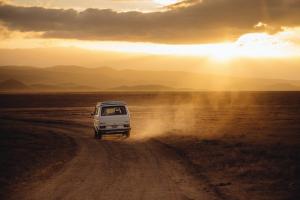- 19 reads

As summertime fast approaches, we begin to prepare for warm weather adventures. A favorite American pastime is traveling across the country during a summer road trip. What most of us fail to realize is the effects that cross-country travel have on the environment, including the high amount of carbon emissions, waste generated, and added pollution. While most of us do not want to add to the degrading environment, we all deserve the chance to take a fun road trip. The following are five steps that you can take to “green” your road trip and reduce your vacation carbon footprint.
-
Rent a Fuel-Efficient Car- If you already own a fuel-efficient car, give yourself a pat on the back, pack up the car and get your vacation started. For those of us that have not updated our car to an energy-efficient vehicle, consider renting one for your trip. Reduced carbon emissions and gasoline consumption plays a large part in the effect that your road trip has on the environment, since Americans travel an average of 2.9 trillion vehicle miles a year. Additionally, the amount of money saved on gasoline can go towards the cost of renting the car.
-
Pack Your Own Food- A large amount of waste is created when getting your food to go or by eating fast food. A to-go hamburger is wrapped in a piece of paper, placed in a cardboard box, which is then put inside a paper bag with numerous napkins and single serve packets of condiments. Pack along your own food to reduce the amount of waste produced around your meal time. Purchase bulk food items and use reusable plates and cutlery. Pack along a small camp stove to heat your food and turn the back of your car into a camp kitchen. If you are camping out while crossing the nation, try cooking over a campfire, but don’t forget the s’mores!
-
Ditch the Lead Foot- Green cars, like the Prius, will show you how unnecessarily fast acceleration and erratic braking can negatively affect your gasoline consumption. The dashboard display shows you real-time miles per gallon usage and allows you to see how your acceleration, changing gears and braking affects it. Driving is not a race, and there is no need to take off from the crosswalk line like a NASCAR driver. Road trips give you the opportunity to experience the landscape in a different way than airplanes afford. Take the time to soak it in and don’t try to rush along, and also save you a few dollars in gasoline money. Setting your car to cruise control will also help you use fuel more efficiently.
-
Bring Your Favorite Mug and Water Bottle- If you are a typical coffee-guzzling American, make sure to pack your own cup. If you purchase one disposable cup of coffee per day, you will accumulate 23 pounds of waste per year. The use of plastic water bottles is an increasing problem every year. This overly-convenient piece of waste is quickly filling the landfills, with only a quarter of them making it to a recycling station. Reduce the waste generated on your trip by kindly asking your barista to rinse your reusable mug and fill your water bottle when you make a stop to hydrate and fuel up on caffeine.
-
Check Your Tires and Get a Tune Up- Make sure your car is up to date on oil changes and other routine maintenance. Car fluids and engine parts are not easily recyclable. By maintaining your vehicle you are helping to keep items out of the landfill and help to reduce your traveling carbon footprint.
-
Replacing your spark plugs will cut down on battery use and delay having to replace it as often.
-
Checking the air in your tires can improve your gas mileage by 3.3 percent.
-
A tire safety check can prolong the life of your tires and keep them out of the landfill longer.
-
Replacing your air filter can improve fuel efficiency by 20 percent.
While you are out on the road this summer, do your best to minimize your impact on the world you are out to experience. By following the steps above, you can proudly go out and explore without leaving a heavy carbon footprint.

